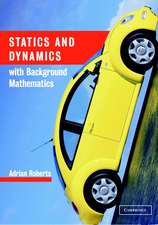Engineering Entrepreneurship from Idea to Business Plan: A Guide for Innovative Engineers and Scientists
Autor Paul Swamidassen Limba Engleză Paperback – 25 oct 2016
Preț: 322.89 lei
Nou
Puncte Express: 484
Preț estimativ în valută:
61.79€ • 64.27$ • 51.01£
61.79€ • 64.27$ • 51.01£
Carte tipărită la comandă
Livrare economică 14-28 aprilie
Preluare comenzi: 021 569.72.76
Specificații
ISBN-13: 9781107651647
ISBN-10: 1107651646
Pagini: 254
Dimensiuni: 177 x 252 x 11 mm
Greutate: 0.54 kg
Editura: Cambridge University Press
Colecția Cambridge University Press
Locul publicării:New York, United States
ISBN-10: 1107651646
Pagini: 254
Dimensiuni: 177 x 252 x 11 mm
Greutate: 0.54 kg
Editura: Cambridge University Press
Colecția Cambridge University Press
Locul publicării:New York, United States
Cuprins
1. Engineers create value for investors; 2. Introduction to technological innovation; 3. The seven phases of technological innovation; 4. Engineers add value in stages; 5. Disruptive technological innovators: value creators; 6. Ideas: how do you find them?; 7. Turn your idea into a product; 8. Early detection of market potential A. David Mixson; 9. Illustrative case: tennis racquet customer needs survey; 10. What engineers can do for product development; 11. Intellectual property, patents and trade secret; 12. If you cannot afford a patent attorney; 13. Reading and learning from a granted US patent; 14. Patent search and conclusions before drafting a patent application; 15. Pro se US patent applications do succeed; 16. Macroeconomics for innovators in engineering and science; 17. Customers, target markets and marketing; 18. The power of social media marketing Haitham A. Eletrabi; 19. Market analysis resources; 20. Illustrative case: market analysis for tennis racquets; 21. Competition research; 22. Manufacturing and sourcing; 23. Break-even analysis; 24. Sales and distribution - wholesale, direct and other; 25. Reaching your customer: advertising and promotion; 26. Selecting the pre-start-up model; 27. Key decisions: costs estimation and pricing; 28. The business model versus the business plan; 29. The business plan: the end of phase 3; 30. A business plan is a war plan: anything can change; 31. Making the start-up business financially feasible; 32. What angel investors look for in a phase 4 company seeking funding; 33. Ethics in engineering and business professions; 34. Business as a legal entity in the United States; 35. Pre-start-up business organization and management; 36. An illustrative case: Amazon.com as a start-up; 37. Execution phases 4 to 6; 38. Phase 7: six case studies of mature firms; 39. Comparing phase 7 firms from different industries: Apple and Wal-Mart; 40. Teams and teamwork; 41. Leadership issues in start-up business Jay Clark; 42. What we know about entrepreneurs; 43. Creating value as an engineer in India Hephzibah Stephen.
Recenzii
'A particularly strong contribution the author makes is his attention to the importance of intellectual property, something often missing in the training of scientists, in particular. Not only does he do a good job of explaining the process of patenting, as well as the structure of the United States Patent and Trademark Office and their processes, he spends time outlining the opportunity for pro se applicants. This is often left out of texts of this type. The author clearly has experience in this latter approach … On balance, I consider Professor Swamidass's book should be considered by any instructor as a candidate for acceptance as either the text, or at least a reference, for a course focused on scientists and/or engineers. That could be true for either graduate students or undergraduates based on the background of the instructor.' Charles E. Hutchinson, Dean Emeritus, Thayer School of Engineering, Dartmouth College, Hanover
'On balance, this is an easy to follow book which offers a good perspective on how a person interested in technological development should act to surmount all the hurdles and invites the readers to be more confident and to pursue on the road to a new business development … In the book preface, Swamidass states that the book is addressed to innovative engineers and scientists who desire to become income-producing businessman or potential investors. As such, the book meets the expectations, but may also be used by anyone interested in studying to better stimulate their own entrepreneurial/intrapreneurial abilities, potentially leading to business development in technology. I would recommend the book for instructors in entrepreneurship and their students as an important reference, as the book uncovers many of the multifaceted practical aspects of what it takes to become a first-time inventor and first-time business owner. Daniela Cristina Momete, International Small Business Journal: Researching Entrepreneurship
'On balance, this is an easy to follow book which offers a good perspective on how a person interested in technological development should act to surmount all the hurdles and invites the readers to be more confident and to pursue on the road to a new business development … In the book preface, Swamidass states that the book is addressed to innovative engineers and scientists who desire to become income-producing businessman or potential investors. As such, the book meets the expectations, but may also be used by anyone interested in studying to better stimulate their own entrepreneurial/intrapreneurial abilities, potentially leading to business development in technology. I would recommend the book for instructors in entrepreneurship and their students as an important reference, as the book uncovers many of the multifaceted practical aspects of what it takes to become a first-time inventor and first-time business owner. Daniela Cristina Momete, International Small Business Journal: Researching Entrepreneurship
Notă biografică
Descriere
This book shows engineers and scientists how to create new products that are income-producing for themselves and for investors.




















